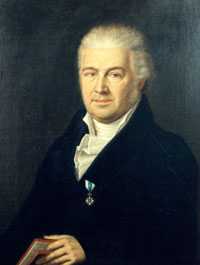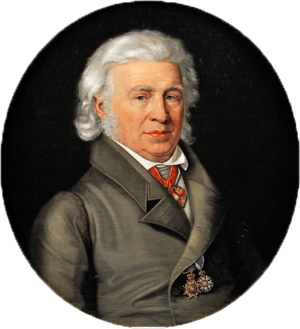Samuel Thomas von Sömmerring facts for kids
Quick facts for kids
Samuel Thomas von Sömmerring
|
|
|---|---|

Portrait by Wendelin Moosbrugger
|
|
| Born | 28 January 1755 |
| Died | 2 March 1830 (aged 75) Frankfurt am Main
|
| Nationality | German |
| Alma mater | University of Göttingen |
| Scientific career | |
| Fields | medicine |
| Doctoral advisor | Ernst Gottfried Baldinger |
Samuel Thomas von Sömmerring (born January 28, 1755 – died March 2, 1830) was a smart German scientist. He was a doctor, an expert on the human body (anatomist), and studied ancient life (paleontologist). He was also a clever inventor! Sömmerring found a special spot in the human eye called the macula. This part helps us see clearly.
He studied the brain and nervous system a lot. He also looked at our sensory organs, like eyes and ears. His work on how babies develop and how lungs are built made him a very important anatomist in Germany.
Contents
Life and Work
Samuel Thomas von Sömmerring was born in Toruń, a city that was part of Royal Prussia back then. He was the ninth child of a doctor. In 1774, he finished his schooling in Toruń. Then he started studying medicine at the University of Göttingen.
He became a professor of anatomy in Kassel. Later, in 1784, he taught at the University of Mainz. For five years, he was the head of the medical department there.
Moving to Frankfurt
When the French took over Mainz, Sömmerring moved to Frankfurt in 1795. He opened his own medical practice. He did something very important there: he helped bring vaccination against smallpox to the area. This was a big step in keeping people healthy. He also became a key member of a natural history society.
He received job offers from other universities. But in 1804, he accepted an invitation to join the Academy of Science in Munich. In Munich, he became a court counselor. He was even given a special title, becoming part of the Bavarian nobility.
Discoveries and Inventions
When Sömmerring was only 23, he described how the cranial nerves are organized. This was part of his doctoral work, and his study is still used today! He wrote many books and papers. These covered topics like medicine, how the body works, and even paleontology.
He wrote about ancient crocodiles. In 1812, he described a flying reptile called Ornithocephalus antiquus. Today, we know it as a Pterodactylus. He was also the first to draw a very accurate picture of a female human skeleton.
Sömmerring was a very creative inventor. He designed a telescope for looking at stars. In 1809, he even created an electrical telegraph. This was a way to send messages using electricity. He also worked on improving wine and studying sunspots. In 1811, he developed the first telegraph system in Bavaria. You can see it today at the Deutsches Museum in Munich. In 1823, he became a member of the Royal Swedish Academy of Sciences.
Family Life
Sömmerring was married to Margarethe Elizabeth Grunelius. Sadly, she passed away in 1802. They had a son named Dietmar William and a daughter named Susanne Katharina.
Because of bad weather, Sömmerring left Munich in 1820. He moved back to Frankfurt, where he died in 1830. He is buried in the city's main cemetery.
A type of bird, the Western jackdaw, has a subspecies named after Sömmerring. It's called Corvus monedula soemmerringii. This bird lives in parts of Europe and Asia.
Important Writings
Sömmerring wrote many important books and papers during his life. Here are some of them:
- About the Physical Differences of the Moor from the European (1784)
- About the Brain and Spinal Cord (1788)
- About the Structure of the Human Body (1791–96, 6 volumes)
- About Diseases of the Absorbing Vessels of the Human Body (1795)
- Table of the Female Skeleton (1798)
- Illustrations of the Human Eye (1801)
- Illustrations of the Human Organ of Hearing (1806)
- Illustrations of the Human Organs of Taste and Voice (1806)
- Illustrations of the Human Organs of Smell (1809)
His letters with another scientist, Georg Forster, were also published.


